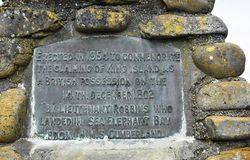
Home » Themes » Landscape » Settlement
Claiming of King IslandPrint Page 
An obelisk commemorates the claiming of King Island as a British possession by Lieutenant Robbins in December 1802.
Acting under private instructions from Governor Philip King of the British colony of New South Wales, acting Lieutenant Robbins was hastily sent south from the Colony of Port Jackson (Sydney) to locate the French Admiral Baudin in late November 1802.
Baudin was conducting scientific expeditions in the region with two ships, and although on good terms with Governor King, the Governor had heard of comment from Baudin`s men that they planned to establish a settlement in the D`Entrecasteaux Channel.
Lieutenant Robbins caught up with the two French boats, the Naturaliste and Le Geographe, at King Island, where he ceremoniously claimed the Island, the Strait and Van Diemen`s Land for the Crown - hoisting the British Flag in a large gum tree and firing three volleys in salute low over the nearby French tents. Luckily the French, who numbered nearly one hundred, treated the incident with ridicule and not with force, as Lieutenant Robbins and crew from the schooner Cumberland numbered only 17 and also needed to borrow from the French the gunpowder for the salute.
Baudin latter commented in a private letter to Governor King about "That childish ceremony was ridiculous, and has become more so from the manner in which the flag was placed, the head being downwards and the attitude not very majestic. I thought at first it might have been a flag which had served to strain water and then hung out to dry".
Hundreds of King Island residents travelled by every form of available transport to attend the unveiling of a monument erected to commemorate the first landing on the island in 1802. The ceremony was organised by the local sesquicentenary committee, under the chairmanship of the deputy warden of the municipality (Cr. Ross). East coast residents by voluntary labour had constructed a cairn-a five feet high pyramid. It overlooks the broad sweep of the beach at Sea Elephant Bay. A bronze plaque set in the memorial records: "Erected in 1954 to commemorate the claiming of King Island as a British possession on December 14, 1802, by Lieut Robbins who landed in Sea Elephant Bay from H.M.S. Cumberland." Cr. Ross thanked his committee and those who had worked so hard in the matter and then introduced the Warden (Cr. Marshall). In turn, Capt. Hooper (a former Warden) also spoke and traced the romantic history of the area pointing out that Lieut. Robbins raised the British flag in spite of the hostile presence of the French ships Le Geographe and Le Naturaliste under the command of Nicholas Baudin. The final act was when Mr. Hickmott Grave, who has spent his 73 years on King Island, unveiled the plaque and the flag was broken nearby by Mr. W. J. Lightfoot while the captain of the rifle club (Mr. D. M. Paterson) fired a volley over the spot. The committee distributed sweets to the children.
Examiner (Launceston, Tas.), 2 April 1954.
Location
| Address: | Esplanade, King Island, Naracoopa, 7256 |
|---|---|
| State: | TAS |
| Area: | AUS |
| GPS Coordinates: | Lat: -39.921018 Long: 144.124395 Note: GPS Coordinates are approximate. |
Details
| Monument Type: | Monument |
|---|---|
| Monument Theme: | Landscape |
| Sub-Theme: | Settlement |
| Actual Event Start Date: | 14-December-1802 |
| Actual Event End Date: | 14-December-1802 |
Dedication
| Approx. Monument Dedication Date: | 1954 |
|---|
Erected In 1954 To Commemorate
The Claiming Of King Island As
A British Possesion On The
14th. December 1802
By Lieutenant Robbins Who
Landed In Sea Elephant Bay
From H.M.S. Cumberland.






